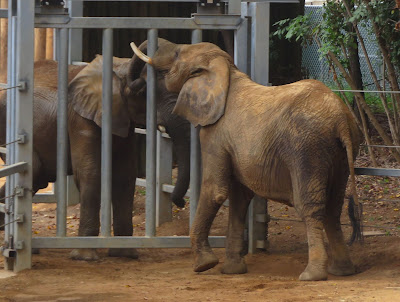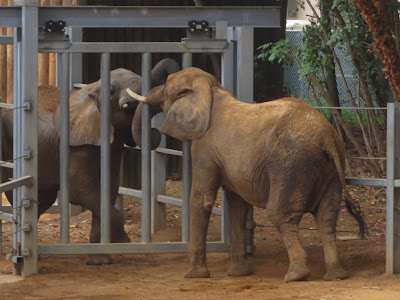Took a dear friend to the Maryland Zoo yesterday and got to share one of my favorite places with her. We took our time and got to see many of my favorite aspects--as with all zoos, you're always at the mercy of the animals. Here are some pics.
"You lookin' at me, kid?"
BLACK-TAILED PRAIRIE DOGS
AFRICAN ELEPHANTS
The Maryland Zoo's African Elephant herd consists of four animals: The adult bull, Tuffy (36), two adult females, Anna (44) and Felix (36), and one adolescent male, Samson (11). Samson was born at the Maryland zoo to Felix and Tuffy. While both genders of African Elephants grow tusks, neither Tuffy nor Felix have them. Below, Samson is participating in a keeper healthcare check, and Anna has come over to keep him company. As the Matriarch of the herd, Anna, is very deferential to the feelings of the others.
The elephant's home at the zoo has just undergone a $20,000,000.00 upgrade that has nearly tripled their available space and made it possible to potentially increase the size of the herd. Hear, Felix is exploring a rock for a hidden treat possibly. It is hoped that she and Tuffy will again produce a second offspring.
COMMON WARTHOG
"How's the wallow today, darling?" "Divine, my dear, do join me!"
Our Warthogs are companion animals. Keewee was born at the Maryland and Hoda was transferred from the Detroit Zoo to join her.
ADDRA GAZELLE
The Maryland Zoo was home to three of these critically endangered members of the gazelle family: Mukuru, the male, and Wren and Pipit, females. Then this past autumn we welcome two new members as both Wren and Pipit gave birth. Happily Merle and Magpie joined the flock.
LESSER KUDU
Lemon and Meringue are our two adult females.
VON der DECKEN HORNBILLS
The female has the black bill and the male's is red and yellow.
BLUE DUIKER
Lucky is arguably our lucky little male Blue Duiker. Arriving at the zoo from the NEW Zoo in Wisconsin on a breeding recommendation of the AZA's Species Survival Program, he and Flower successfully saw the birth of their first offspring earlier this month. A little female, yet to be named.
Blue Duikers live in arboreal habitats and are a little larger than a well-fed domestic cat.
 SOUTHERN WHITE RHINOCEROS
SOUTHERN WHITE RHINOCEROSYes, Stubby is a white rhino and not an orange one. But thanks to his love of his orange clay wallows, you'd be forgiven for making that assumption! Stubby was born at the Knoxville Zoo and came to us at the age of 3 in 1996. I am a stubby fan, period.
SANDHILL CRANE
I wonder if she is nesting. I have never seen one adhere themselves to the ground in this manner before.
LITTLE GREEN HERON
LITTLE GREEN HERON



















No comments:
Post a Comment